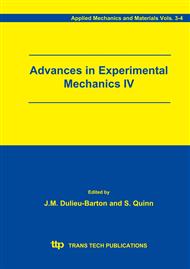p.331
p.337
p.343
p.349
p.355
p.363
p.369
p.377
p.383
On the Feasibility of Thermoelastic Stress Analysis on Rapid Prototyping Models
Abstract:
This work discusses application of the thermoelastic technique to the stress analysis of Rapid Prototyping (RP) models. The aim is to evaluate the possibility of conducting complete and effective structural tests on prototypes made by means of stereolithography (SLA). The analyzed material is an RP Cure 600 ND epoxy resin. A statistical approach was followed to evaluate the sensitivity of the thermoelastic behaviour of the material to some SLA characteristic parameters. In addition, the effect of load cycle frequency on thermoelastic signal was also analyzed. The experimental work included forty-eight tests on ASTM standardized specimens. A new testing procedure was developed for resin-made models. The new method is based on the application of a loading ramp to SLA standard specimens and on the acquisition of the infrared signal. The thermoelastic constant K is determined using the thermographic signal temporal slope. Results for an engine bracket are presented in the paper.
Info:
Periodical:
Pages:
355-362
Citation:
Online since:
August 2006
Authors:
Price:
Сopyright:
© 2005 Trans Tech Publications Ltd. All Rights Reserved
Share:
Citation:


